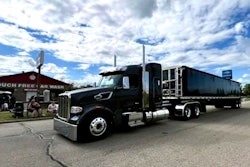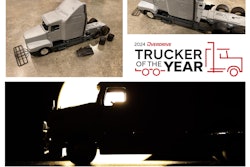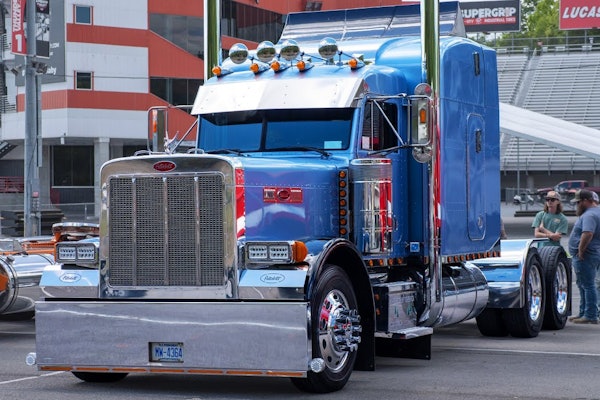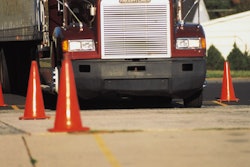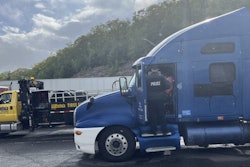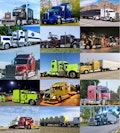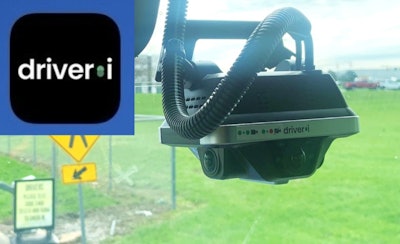
As I taxi my way out of a massive Midwest grocery-warehouse complex, I make a full stop at the abandoned railroad track, the one with the faded stop sign all the spotters disregard. Why? The Driver.i app doesn’t like it when I run stop signs, and I’ve got to keep my GreenZone score above 950 to get my monthly bonus.
The Netradyne Driver.i app and its real-time performance scoring is definitely living rent-free in my head. The carrot? A two cents/mile thank-you for all the miles driven in a month that comes in like clockwork on the first check of the next month. You can do the math. At 100,000 miles a year, that's an extra $2,000, or a couple house payments for me.
Working for a company with outward-facing cameras, the process seems fairly innocuous. I almost hate saying this out loud, for fear of my old-school readers’ reaction, but driving with automated coaching like this doesn’t seem that big of a deal. Stop completely at stop signs, be mindful of following distance, watch your speed. Big whoop.
If you hear the female voice of your AI coach saying “Please slow down,” you probably should slow down, though she is certainly wrong sometimes. Such as: When you get the green light at the Florida scales and she reads the bypass-lane sign of 45 mph and barks, ‘Please slow down!’ Speed up just for spite because she reminds you of an ex-wife? You’re probably going to lose points.

'Space-age snake oil'?
 Here, my monthly scores thus far in April, as shown in the app on my phone. The "GreenZone" shows the cumulative average for all days worked. Below in the purple is my ranking among other company drivers. Driver stars show elongated periods of system-designated "safe" driving, and alerts are incidents such as detected speeding or running a red light.
Here, my monthly scores thus far in April, as shown in the app on my phone. The "GreenZone" shows the cumulative average for all days worked. Below in the purple is my ranking among other company drivers. Driver stars show elongated periods of system-designated "safe" driving, and alerts are incidents such as detected speeding or running a red light.
Despite Netradyne’s claims of their software possessing the capability to contextualize incidents, Wesley remains unconvinced.
"My camera is wrong about everything," he said, "but the ‘maintain safe following distance’ warning is the best example." He described coming around a curve in the right lane, then seeing "law enforcement with lights illuminated" up ahead in the breakdown lane.
Wesley tells the tale of what happens next this way:
I have a spot I can merge into in the passing lane, but to do so, I’m going to have to change lanes behind the CMV who just passed me going 5 mph faster. I complete my maneuver 30 feet off of the rear of the passing trailer and the camera bleats its warning after me. Neither I nor the passing truck are in any danger, because we already know the whys and hows of such a maneuver. The Silicon Valley lads who programmed the Driver.i system happily add a demerit to my "score" nonetheless.
Another example? The old highway-speed "cut-off," when a passing four-wheeler merges back into the truck's lane, say, "20 feet off of my front bumper," Wesley said. The kind of situation, in other words, that pretty much every truck driver in the nation, every single day, experiences.
Wesley said the remedy for avoiding getting dinged by the application would be to "stand on my brakes in traffic," creating an unsafe situation for trucks and passenger vehicles behind him.
[Related: A highway-speed-cutoff PSA]
For what it's worth, I don't get that verbal following-distance warning, but the Driver.i system is customizable, with different configurations company to company. And keep in mind, unlike the configuration in my truck, Wesley's got the driver-facing camera, too.
"I’ve had the camera complain I ran a stop sign that wasn’t facing my lane," he said. "I was talking to myself once on a long stretch of open highway, and it said something I wasn’t able to catch, thankfully, as I’d probably have descended into uncontrollable anger. It even complains about my yawning when I’m not tired, just bored."
Wesley feels there are industrial processes software/hardware combinations like the Driver.i system "can and probably should be monitoring," he said, but driving isn't one of them. In his view, the system is attempting to "reduce a complicated job ... and the good judgment that arises from years of experience to a series of out-of-context measurements." He went on to call it "space-age snake oil at best.”
Netradyne boasts a client base including Prime, Knight and Halvor Lines, and says its coaching technology and real-time driver feedback has reduced accidents by 50%, a stat that has fueled growth internationally, too. The company now has clients now in India, Mexico and Europe. Adam Kahn, Chief Business Development Officer of the California-based company, pushes back on the whole uninitiated Silicon Valley tech punk rap some drivers have thrown their way.
“My father worked for Ford Heavy Trucks for 35 years," helping launch "the Aeromax and the LT9000," Kahn said. "I’ve been around trucks all my life. Netradyne ... has a number of ex-VPs and safety directors from [multiple trucking companies]." Though they may be cast as a "California start-up company, we have deep roots with our team in the trucking industry. One of the things we tried to do at Netradyne is to build a system around the carrot and not the stick."
The goal? To "identify the best drivers," as he put it. "The premise of Driver.i is to reward drivers for elongated positive performance.”
With respect to the way the app produces scores, Kahn identified four main areas of focus with the strongest connection to accidents. He calls them “the biggies.” They are:
- Severe speeding
- Stop sign compliance
- Following distance, and
- Sign compliance generally.
Failures in these areas will detract points. Conversely, elongated periods of compliance can add points, or stars.
For Phil M., former owner-operator and current 5 million mile trucker, the coaching app has improved his awareness, he said. It's help him be “more aware. For example, I never knew the speed limit in Indy was 50 mph. But when it dinged me seven times one day, I told [the company safety man], ‘I think there’s something wrong with this camera.’ Then I realized there was a fifty mile an hour zone there.”
Phil's company only utilizes outward-facing cameras. He summed his experience up this way: “I’ve always been an outlaw, but when there’s money on the table, I really don’t mind it.”
[Related: In-cab and out, camera options expand amid push-pull of privacy concern, regulatory attention]
I’ve wondered how Phil’s experience, as well as my own, could be so different from Wesley’s. It’s the same tech company, same camera (at least for the road), same application. It sounds like Wesley’s company has thrown every command option at him but the kitchen sink, and the interior-facing portion of the camera and has scrutinized him, too, not just those road signs other vehicles.
Moreover, he’s unaware of any reward that’s on the table if he attains certain metrics where he's leased. Possibly all stick and no carrot?
The only audible warning from the AI coach I’ve ever gotten is "please slow down." One has to wonder if it’s all in who is implementing said technology. Wesley’s company will take you with no previous experience, train you and put you on the road. Maybe he’s a casualty of a lowest-common-denominator management model. You’ve got to have one year’s verifiable experience to even be considered where I work.
My truest sense of this system is that it can help if you’re coach-able, so to speak, and the people you’re working for aren’t using the technology to beat you over the head. For now, Netradyne is fast becoming a household name, at least around my house. Today we stopped at Aldi and my driver, who shall remain nameless, was a little crooked and hanging over the line of her parking spot. Well, for the sake of the story, let's just call this person Bernice Darhoefer.
I told her, “Maybe you should square that up a bit, Bernice.”
“Stop Netradyning me!” she said.
[Related: Can AI transform the prying eyes of driver-facing cameras?]





